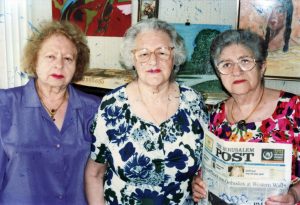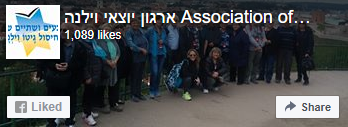Sara Libman Chotiner
 The Libman family lived in the town of Eržvilkas, Tauragė County. They were a large and well-known family, the owners of a bakery and a grocery shop. At the beginning of the German occupation, the Libmans were forced to leave their house and move to the local ghetto, located in one of the poorest streets of the town. Seeing that the situation was worsening, the parents pushed their children to run away and seek refuge with their Lithuanian friends. In August 1941, Sara Libman (later Chotiner) and her sisters, Luba (later Jezierski) and Chava (later Leibovich), came to the estate of a prewar acquaintance and local landowner, Jasius Gudavičius. Gudavičius hid the three Jewish sisters in the barn’s loft and for several weeks cared for all their needs. Later, their brother Akiva Libman, and a relative from the town of Kelmė, Orchik Kelz, and his wife, Sore-Beile, joined them. Since Gudavičius had several workers who came daily and sometimes stayed overnight on the estate, the Jews decided to look for alternate shelter. After wandering, together and separately, for some time, the whole group came to the house of Jonas and Petrunelė Zaronas, a poor, childless couple. They also were customers of the Libmans before the war. The Zaronases built a bunker and hid their friends for quite a long period.
The Libman family lived in the town of Eržvilkas, Tauragė County. They were a large and well-known family, the owners of a bakery and a grocery shop. At the beginning of the German occupation, the Libmans were forced to leave their house and move to the local ghetto, located in one of the poorest streets of the town. Seeing that the situation was worsening, the parents pushed their children to run away and seek refuge with their Lithuanian friends. In August 1941, Sara Libman (later Chotiner) and her sisters, Luba (later Jezierski) and Chava (later Leibovich), came to the estate of a prewar acquaintance and local landowner, Jasius Gudavičius. Gudavičius hid the three Jewish sisters in the barn’s loft and for several weeks cared for all their needs. Later, their brother Akiva Libman, and a relative from the town of Kelmė, Orchik Kelz, and his wife, Sore-Beile, joined them. Since Gudavičius had several workers who came daily and sometimes stayed overnight on the estate, the Jews decided to look for alternate shelter. After wandering, together and separately, for some time, the whole group came to the house of Jonas and Petrunelė Zaronas, a poor, childless couple. They also were customers of the Libmans before the war. The Zaronases built a bunker and hid their friends for quite a long period.
Jonas Zaronas was in touch with Jaroslavas Rakevičius*, who hid the Zarkin family on his farm and had good conditions for hiding more Jews. Through Zaronas, the Libmans appealed to Rakevičius and requested that he accept their relatives. Rakevičius not only agreed, but also went with his cart to Kaunas and, with the help of Petronė Butkienė, took out of the ghetto Sara Ziv (later Graber), and her sister Liebe Raibstein with her four-year-old daughter, Mirele. The three of them were first hidden by Rakevičius and thentransferred to Petrė Beleckienė, a poor but noble peasant living in the area. In the meantime, Butkienė and Rakevičius brought more Jews from the Kaunas ghetto (Harry Goldstein, the Meltz couple and their baby daughter, Lea Brik and son, and others), who were accepted by local peasants, among them Pranas Bajorinas, Stefa Pocienė, Bronislava Paulauskienė, the Mozūraitis* family and the Kurpauskas* couple. Those who previously stayed at the Zaronases also changed their hiding places, for safety reasons. For a while, they were hiding at the house of Dominikas Toliušis*, then the group split up and everybody hid at a different address (partly mentioned above). Sara Libman found shelter with Juozas Šveistys, a wealthy landowner, who lived with his wife and son. The local police suspected the Šveistyses for their sympathies to Jews and one day a thorough search was made of their estate. Luckily, Sara, who was hiding under the straw heap, was not found. Towards the end of the occupation, the Libmans again gathered together under the roof of Jonas Zaronas. In October 1944, the area was liberated from Nazi occupation. After the war, the majority of the rescued left for Israel and other countries, but kept in touch with those who took part in their rescue. On July 15, 1981, Yad Vashem recognized Petronė Butkienė and Stefa Pocienė as Righteous among the Nations. On January 27, 1982, Yad Vashem recognized Jasius Gudavičius, Jonas and Petrunelė Zaronas, Petrė Beleckienė, Pranas Bajorinas, Bronislava Paulauskienė, and Juozas Šveistys, as Righteous among the Nations.
From: Yad Vashem


